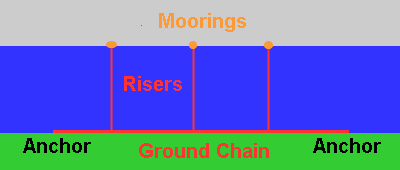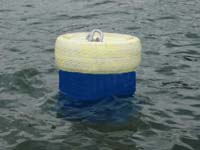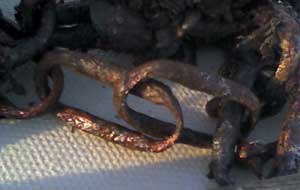Mooring to a buoy is generally fairly relaxed compared to arriving at a pontoon. If you get it wrong most buoys will just bounce off and you can go around again and have another go.
Buoys
Most moorings consist of a ground chain attached to a heavy object that is buried in the sea bed or to anchors at either end, on some moorings this weight could be a block of concrete or old engine block. The moorings may be individual or on a "trot", that is a line of moorings attached to a long heavy chain on the bottom. If the bottom is mud, the sinkers or anchors will gradually work their way in to the bottom and become very secure. If the sea bed is hard sand or compacted dead coral the moorings may be made by screwing an anchor point into the bottom.

 The main mooring buoy is often too heavy
The main mooring buoy is often too heavy to lift as it has to be big enough to support the heavy riser chain. There is normally a ring on the top of the buoy to moor to, and to make picking the mooring up easier, there is often a "pick up" line attached, this may have a small buoy on the end, like to one on the right.
to lift as it has to be big enough to support the heavy riser chain. There is normally a ring on the top of the buoy to moor to, and to make picking the mooring up easier, there is often a "pick up" line attached, this may have a small buoy on the end, like to one on the right.
If you are picking up a mooring in an area that you do not know you should ensure that it is strong enough to support your vessel. If not, you may pull it out of the bottom and damage the mooring as well as your vessel. There may be information available about the size of the vessels that the mooring is suitable for marked on the buoy or in the local sailing directions, in environmentally sensitive area, especially with coral bottoms there may be strict regulation of mooring and anchoring.
Around the World there are many organisations laying moorings that are intended to reduce the damage to the seabed caused by anchor chains dragging across coral reefs, one anchor can destroy 100s of years of coral growth overnight. If you sail near areas of coral make sure you know what the arrangements are, the fines for damaging a reef can be very large.
Well managed moorings are lifted annually so they can be serviced and assessed for damage, in many places this is not done and if you are on a mooring during strong winds the mooring may fail because of lack of basic maintenance. On a few occasions I have gone on deck in the morning after a rough night and seen 2 or 3 boats on the beach still attached to their mooring buoys.
Preparation
You will need a boat hook ready to hand, it is worth briefing a novice crew to pull along the length of the boat hook, not to lift with it at arm's length, it is easy to break a hook if it is used like a crane rather than to pull with. If a heavy weight is lifted in the manner of the hook on the right there is a good chance the hook will bend or snap.
to pull along the length of the boat hook, not to lift with it at arm's length, it is easy to break a hook if it is used like a crane rather than to pull with. If a heavy weight is lifted in the manner of the hook on the right there is a good chance the hook will bend or snap.
It is useful to have a mooring rope ready when you approach the buoy, if the mooring has a ring on the top you will need to attach your line to the buoy as quickly as possible.
Approach
Aim into the tide or if there is no tide, in to the wind. If it is not clear where to approach from look for a similar type of vessel and approach the buoy on a parallel heading. If there are no other vessels, the direction of the pick up line will indicate the direction of the tide.

As you are approaching the buoy it is best to keep it to one side of the bow slightly, this will enable you to see it for longer, the crew should be on the other side of the boat and only step forwards at the last moment to avoid blocking the helm's view. It is vital that the vessel does not pass between the main buoy and the pick up one, the danger is that the line will snag on the propeller or the rudder.
Some skippers like the crew to count the distance to the buoy down in feet or metres. This can help once the buoy is out of sign under the bow, I find it works best with a crew that is used to sailing together, with an unfamiliar crew there is a little adjustment time until everyone is familiar with the rest of the crew.
The best judgment of speed will come from looking to one side to create a transit. Once the buoy has disappeared under the bow, speed is very hard to estimate, but if you look to the side you can easily see if you are still moving or not.
If the crew with the boat hook is briefed to point the hook at the buoy it may help the driver to position the boat.
On a larger or high decked vessel, it is easier to pick the buoy up at the lowest point of the deck, this is normally about 2/3 of the way aft. Once the crew have the buoy, the vessel needs to be gently reversed until the buoy is on the bow. On some vessels or if you are alone it may be best to reverse on to the buoy, just take care not to foul the propeller.
Mooring
Once at the buoy, the boat must stop and stay stopped relative to the buoy long enough that the crew can attach the boat to the buoy. Frequently you see a boat slowly dropping back until the load is fully on the boat hook, the crew can not release the hook from the buoy because of the pressure and when it is ripped from the foredeck crew's hands the skipper blames the crew. This situation it is always caused by poor boat control, the helm must keep the boat stopped, this may mean subtle use of the engine and steering.
The mooring rope should be pulled in until the main mooring line is reached, this can then be attached to a cleat. If there is no pick up line available, the yacht's mooring line must go to the big ring on the top of the mooring. 
There are several mooring tools that can make life much easier, especially when you are short handed. There are some that clip a carbine hook directly to the ring on the buoy and others that will feed the line through the ring on the buoy for you.
Staying attached
Many boats are left with a single line through the ring on the buoy. That is fine for a few minutes but in gusty conditions the rope will cut through in no time. The best approach is to tie a round turn and two half hitches to the ring on the buoy, and if staying overnight I would always tie two lines to the buoy (I have often seen one knot fail but never two!). The round turn and two half hitches is ideal because the rope does not move very much around the ring on the buoy. If a bowline is used (much easier to undo), it should have an extra turn round the ring.
On larger boats or in more exposed conditions it may be prudent to shackle the anchor chain to the buoy, a well equipped yacht will carry a 5-6m length of chain with a large shackle especially for this purpose. In somewhere like Bray harbour at Alderney ropes will chafe through surprisingly quickly and there are no guarantees that someone will re-moor the boat before the lines snap. If this happens when you are ashore your vessel could be subject to a salvage claim.
Mooring maintenance
A well maintained mooring should be lifted every year and inspected for  corrosion. Commercial moorings are normally lifted and any damaged areas repaired, mooring laid by yacht clubs may not get lifted so often unless the club owns a lifting barge. Moorings laid by private individual may never get any maintenance.
corrosion. Commercial moorings are normally lifted and any damaged areas repaired, mooring laid by yacht clubs may not get lifted so often unless the club owns a lifting barge. Moorings laid by private individual may never get any maintenance.
If you pick up a mooring that you know nothing about, there is a chance that it may be in a very poor condition. Frequently after severe gales I see yachts floating out to sea or washed ashore still attached to their mooring buoy. The chain in the right is the mooring of a yacht I picked up at sea one day where the mooring had snapped in the previous night's gale force winds. The 3/8 inch chain had corroded down to almost nothing at the ends of the links.
If the main mooring buoy shows sign of severe weed growth there is a good chance the mooring has not been inspected for some time.
Take care when using an unfamiliar mooring!
Sailtrain.co.uk is free to use, but if you feel you would like to contribute to the running and development costs you can donate via Paypal:
Additional Resources:

